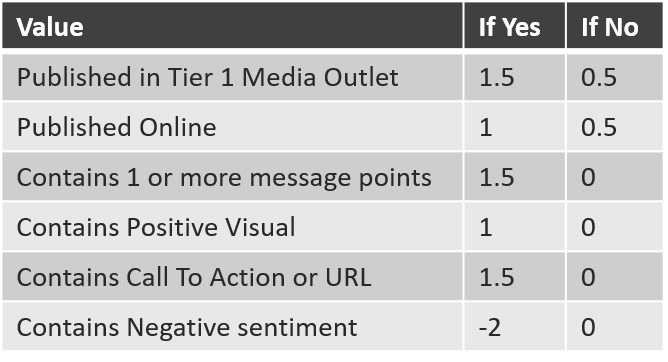I sense a creeping panic setting in at many PR agencies and in-house PR teams.
Their favorite fictitious metric, known as Ad Value Equivalency (AVE), is slowly but surely disappearing from measurement tool boxes around the world.
As I’ve written before, both AMEC and CIPR have vowed to eradicate AVEs in the next year. Members that offer them may not be able to renew, judges of award programs are kicking out any entries that include them, and more and more smart PR pros and marketers are realizing that there are better alternatives out there. Impressions too are increasingly being called into question as they get more and more distorted by fake news, bots, and inaccurate attribution.
But no need to panic. To save everyone a lot of Valium, we offer some AVE alternatives that many of the world’s most successful companies (Southwest, GM, Lockheed, McDonalds, IBM, and Microsoft, to name a few) have been using for years.
Tie your success to business results.
First of all, get consensus on what are the intended business outcomes of your program.
AVEs were really good at demonstrating success in growing column inches, but I’ve never met a CFO or CEO that reported business results in inches. And yes, there were $$$ attached to the results that purportedly showed what those column inches might have cost if you’d been willing to purchase them, but anyone who passed Econ 101 knew there was no real revenue attached, and that no one would have ever paid for most of the coverage that was included.
The reality is that business leaders want to go to their boards and demonstrate growth in market share, sales, market opportunity, or share price. For non-profits it might be donations, volunteers, or other signs of support.
And before you start reaching for your Ativan, you absolutely can show how communications contributes to growth in all those things. The key is to get inside your CMO, CEO, or CFO’s head, and get them to agree on what role you play. That all starts with a frank conversation about what they believe is the connection between what you do and what they want to show the board – in other words, what were you hired to do.
Once you’ve gotten consensus on the business value of what you are expected to deliver, work backwards from those outcomes to define the ways your efforts contribute to those goals. Look for acceptable proxies – i.e. clicking on a “Tell Me More” or “Contact Us” CTA is generally an acceptable proxy for consideration. Once you’ve defined that path, it’s easy to find your AVE alternatives.
Align your metrics to the goals of your program.
It’s a massive misconception that PR activity is an engagement proxy for awareness. It’s not. So, no amount of AVEs or impressions are going to guarantee you that bump in awareness you promised. The reality is that if your goal is to raise awareness, you need to conduct a survey before the campaign and another one after it runs to see if you have in fact raised awareness or changed anyone’s mind.
Which leads us to our second recommendation for an alternative to AVEs: pre/post surveys. Today’s technology has brought down the cost of surveys to practically free, so you can’t claim poverty as an excuse to not do measurement right.
And, if you’re paying for ads and researching their impact on perceptions, you may be able to show that your PR program is a far more efficient way to increase awareness.
For one client I worked with, it turns out that PR was so effective at improving perceptions that when budgeting time came around, the ad budgets were cut, but PR survived.
If your goal is to not just raise awareness but to also change the perception or image of your brand, you will also need to do pre/post studies. But you can supplement that with another acceptable proxy analyzing the conversation around your brand to see if more people are talking about you in the way you want to be perceived. And that’s where media monitoring comes in.
Create a custom media quality score.
One reason for AVE’s longevity in our industry is the myth that it can reduce an entire quarter’s worth of PR efforts into a single number. Never mind that the number is irrelevant, wrong, and misleading. But I get it: if the boss’s attention span is shorter than a two-year-old’s, then you need a single number.
But there’s a better number. It’s called the media quality index (MQI).
The powerful thing about the MQI is that you define “quality” yourself, by what drives your stakeholders to act, customers to purchase, or minds to be changed. It’s a custom index that reflects your organizational priorities.
For example, suppose you’re a tourism destination. Before anyone thinks seriously about planning a trip to your area, your research probably shows that they need to see an attractive photo, read some pleasing information about what makes it unique, and perhaps hear a positive recommendation from a friend or a travel expert. Those are your positive elements.
But there are things that show up in earned media that may deter them from visiting, perhaps an old photo that perpetuates a myth, or a negative review, or misleading information. List those negative elements, too. These are components of stories or posts that leave a reader less likely to do business with or support you.
Assign a weight to each element based on the degree to which it persuades or dissuades a reader from doing business with you. For example, a bad photo might be twice as bad as an incorrect message. Or a desirable photo might be twice as persuasive as a positive mention. Thus, each article gets a net quality score that reflects its impact on the purchase decision.
From that discussion, a table of the elements might looks like this:

Read here how Travel Alberta has instituted its own unique media quality score, and the results it’s had.
Each media item then gets assessed based on the elements and receives a weighted score. Using that score, you can show the increase in average media quality over time and know for sure that you are increasing the likelihood that a reader will consider or prefer your brand. You can also use your MQI score to compare campaigns, media outlets, geographies, or any other variable. It also makes it easy to easily correlate your results to web traffic and other outcome metrics.
Show your impact on consideration.
Attribution is a dirty word in some marketing circles these days because it’s so difficult to gauge accurately, given the multitude of touch points and the difficulty of accurately assigning cause to any one of those touch points. But I’ve successfully convinced many a marketing and communications manager that increased traffic to a “Contact Us” page or the downloading of a purchasing guide is an acceptable proxy for consideration. Thus, if your goal is to generate qualified sales leads or increase the marketable universe, then you can use tools like Google Analytics to track the increase in traffic to those sites that indicate consideration.
Show the value of your conversions.
If you positively must have a dollar sign attached to your results, then sit down with someone in sales who knows your average sale value. Now find your Google Analytics guru and see if they can help you determine an average number of views or pages it has taken in the last six months to get to a sale. Also make sure you agree on what pages customers are most likely to visit before they purchase. Then set up goals in Google Analytics (it’s easy to do; watch my video) to reflect both the source (PR) and the destination URL so you can keep track of your contributions. This works well in e-commerce, but not at all in most B2B companies with long sales cycles, so beware.
Show how you’re growing market share and preference.
If your goal is to increase preference over a competitor, then you need to conduct a pre/post survey to measure the level of preference for your brand vs. the competition. Alternatively, your leadership might be just as happy with a competitive share of voice study that shows you beating the competition in media quality. Agility PR Solutions can do that.







